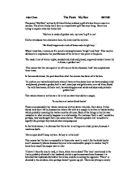Lose something every day. Accept the fluster
Of lost door keys, the hour badly spent.
The art of losing isn't hard to master.
From the next three stanzas, the poet attempts to explain how to master the art of losing things. The first line is a command, to misplace something, anything at all. The poet commands the reader to lose your keys, as a start off on the training course. Yet again there is enjambment, but this time between the opening line of the stanza and the second line. In the middle of the fourth line there is a full stop which signifies that, the first couple of words were a command, and then take a pause. This sudden pause maybe the poet trying to communicate to the reader. In line five there is another pause, but represented by a comma. Villanelle, which is a poetic form composed of syllables and rhymes. There are six stanzas composed of villanelle, and the last line of this stanza shows this as it repeats line one on the first stanza. The repetition is there, maybe to remind the reader what is trying to be taught.
Then practice losing farther, losing faster:
Places, and names, and where it was you meant
To travel. None of these will bring disaster.
In the third stanza, the poet continues her lecture on the basics of mastering losing things, but requests that losing things is done at a speedier pace as to make it more exciting and cleverer. The wording makes it sound like the reader should be reading quick and fast due to the word "faster", but the poet doesn't want the reader rushing into things and tries to slow you down. In line two the poet has broaden the reader's perspectives by what else one can lose apart from keys like "places, and names" and also the places that the reader has been to in his or her life. There is enjambment between lines eight and nine, but if they were put together like most people would do, the syllables structure would be completely broken, leaving the poem with no continuos flow, or significance.
I lost my mother's watch. And look! My last, or
Next-to-last, of three loved houses went.
The art of losing isn't hard to master.
From stanza ten through eleven, the poet has become very intimate and personal about her past experiences of losing things. The poet includes the word "mother", so that the reader comprehends that it wasn't just any watch and that sometime or another it played a huge role in her life. It could have been the only token the poet had of her mother. There are three pauses in line ten, which create a short gap where the poet has time to reflect on what she tries to convey. The poet has now also revealed that it has lost "three houses". Houses usually symbolise good times, good memories and experiences that will forever stick in a person's mind. Again at the end line twelve the first refrain is repeated. The poet is now gradually edging on to a more personal tale, and seems to be getting of track. It starts off with commands and then slides away into personal experiences. Maybe the poet, really hasn't mastered the art, but instead says he or she does to reassure herself self.
I lost two cities, lovely ones. And, vaster,
Some realms I owned, two rivers, a continent.
I miss them, but it wasn't a disaster.
In lines thirteen to fifteen, the poet edges the reader onto the climax of the poem, which is at the last stanza. The poet claims she has lost geographical features and population inhabited areas, but all this is untrue. The poet is naturally attempting to express how much the houses and her old life meant to her before starting to lose things. The poet feels that reader may not understand to what extent the houses meant to its hidden meaning. The poet slows down the first and second stanza, so that the reader is able to digest all the important information
- - Even losing you (the joking voice, a gesture
I love) I shan't have lied. It's evident
The art of losing's not too hard to master
Though it may look like (Write it!) like disaster.
At the last four lines, the poet draws the reader into the whole purpose of the poem. The poet tells the reader of someone that she has lost. Probably a close friend who died or even a family member. Now the importance of the loss of the mother's watch and the continents come into play, because the reader now knows that even the loss of all those things can not add up to what the poet has lost in the last stanza. The poet is obviously devastated at the end stanza and decides that she has had enough. The poet demands that the reader fills in the missing gap by adding "Write it!" This is based on the assumption that the reader has completely understood the message the poet is attempting to convey. The poet is at the moment emotionally questioned, as she may have mastered the art of losing, but has not yet mastered the art of holding in emotions.







